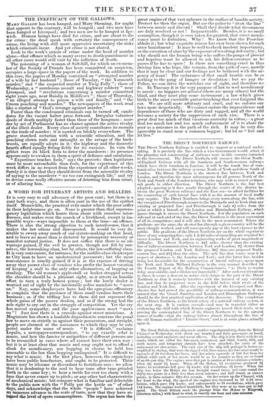THE DIRECT NORTHERN RAILWAY.
Tax Direct Northern Railway is entitled to support as a national under- taking. It is precisely the line which a wise Government would select, if the planning and constructing of railways were in this country intrusted to the Government. The Direct Northern will connect the Great North- of-England Railway with all the Southern and South-western railways which have their terminus in London: it will be the trunk line of com- munication between the railway systems North of York and those South of London. The Direct Northern is the shortest line between York and London, and therefore the most advantageous for all persons North of the York and South of the London terminus, who may wish to travel or trans- mit goods in either direction. The Direct Northern is the line best adapted—passing as it does nearly through the centre of the district be- tween the great Western railways and the East sea—to afford facilities for the connecting of such lateral lines with it as the amount of local traffic may require. The Direct Northern brings every town along the line, with the exception of Peterborough, nearer to the Metropolis and to York than any existing or projected line; and Peterborough is only 4i miles from the point at which a branch of the London and Birmingham Railway, which passes through it, crosses the Direct Northern. For the population on each side and at each end of the line, the Direct Northern is the most convenient of all its competitors; and it will also be the most economical. Where the gradients are the same, the shortest line through a given country will be the most cheaply worked, and will consequently pay at the least expense to the public. The gradients of the Direct Northern are on the whole superior to those of any competing line: only 1 2-3d miles of tunnelling are required be tween London and York, and no engineering works of great magnitude or difficulty. The Direct Northern is 421 miles shorter than the existing line of railway-communication between York and London; 91 shorter than the proposed London and York Railway, 301 than one proposed North- eastern line, and 211 than the other. The only line that comes near it in respect of' shortness is the London and York ; and this latter line, besides being less favourable for the construction of lateral railways, opens upon the York and North Midland Railway in the very manner described by the Fourth Report of the Railway Commissioners, " as likely to render delay unavoidable, and collision not improbable." After such considerations as these, it seems a descent to notice such claims on the part of the Direct Northern as that it scarcely interferes with the interest of any existing line, and that its projectors were in the field before their rivals of the London and York line. After the experiment of the Liverpool and Man- chester line had proved the possibility of railway-communication, it was natural that the Grand Junction and London and Birmingham Railways should be the first practical application of the discovery. The completion of the Direct Northern, as the trunk artery of a national railway system, is the next step. It is curious enough--and may be regarded either as evidencing the skill with which Roman engineers traced their roads, or as proving the contemplated line of the Direct Northern to be the natural course of traffic—that the railway follows almost throughout the line of the old Roman road called " Ermine Street," and is at some places actually upon it.


























 Previous page
Previous page